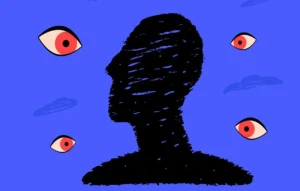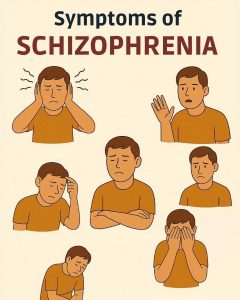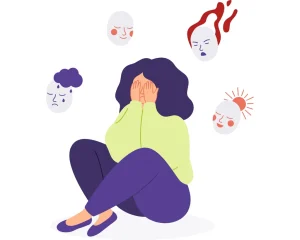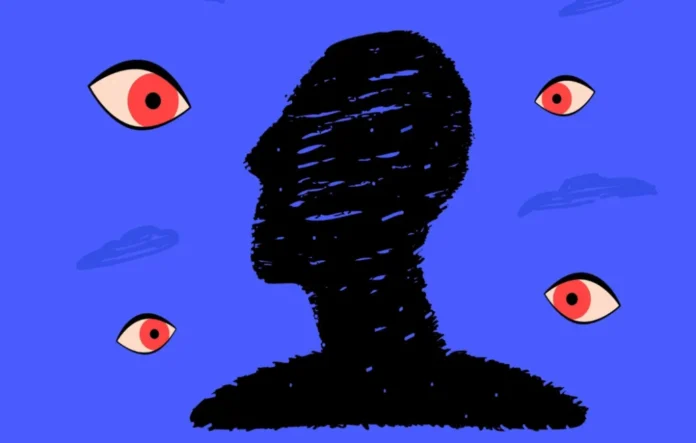Many people find it difficult to understand schizophrenia which has been found to occur in nearly 1 in 100 people around the world. Problems with thinking, feeling, seeing and interacting with others can greatly reduce how someone manages in day-to-day life. The earlier people know about the condition and begin treatment, the better the results tend to be in the long run.

Understanding Schizophrenia
Most of the time, schizophrenia is seen in people who are young adults, with men generally developing the symptoms in their teens or early 20s and women generally between their late 20s and early 30s. In some cases, the signs of psychosis are mild and appear over time and in others they appear all at once as severe psychotic episodes. Though it is a long-term disorder, many people with it can live happy, satisfying lives.
Main signs of Schizophrenia
Symptoms of schizophrenia are usually placed in three groups: positive, negative and cognitive.
Positive Symptoms
Healthy individuals do not display these psychotic actions which consist of things like:
Hallucinations are when a person senses things that others cannot such as hearing voices or seeing certain things.
Delusions involve thinking things that are not true such as having great capabilities or being treated unjustly.
Difficulty speaking coherently and structuring thoughts makes it hard for the person to communicate effectively.
The person may move rapidly or have unusual dances or they could have little or no movement (catatonia).
Negative Symptoms
They lead to changes in standard emotions and how people act:
Flat Affect: Lack of expression of emotions in the way people look or talk.
People with anhedonia cannot feel pleasure as much as they should.
People with avolition struggle to start and keep doing activities that have a purpose.
Why?: People with depression often avoid making connections or attending social gatherings because it is difficult for them.
Cognitive Symptoms
Since they are minor, these can be identified mainly through neuropsychological tests:
Difficulty with using information to make clear choices and decisions.
Difficulty Concentrating: Having problems staying focused on tasks.
Problems with retaining and using new information for a short time.
Signs That Something Could Be a Problem
Noticing early symptoms helps with immediate treatment.
A person isolates from friends and family.
People are less concerned with their personal cleanliness and hygiene.
Paranoia or having strange, unrealistic beliefs.
No Emotions: Not expressing or supporting feelings in a way that feels right.
People may have trouble sleeping (insomnia) or sleep for too long.

There are different forms of Schizophrenia.
At one time, schizophrenia was thought to have several subtypes, but now modern guides do not consider them so much. Yet, knowing about them can help reveal why the disorder varies:
In Paranoid Schizophrenia, people are mostly affected by delusions and hearing voices.
In Disorganized Schizophrenia, a person might speak and behave in a confused way and show inappropriate emotional responses.
Someone with Catatonic Schizophrenia will have movement-related issues, like becoming very rigid or very active.
Residual Schizophrenia: The person still has negative symptoms even when the illness is not active.
What Causes and Increases the Risk

While the cause of schizophrenia is uncertain, some things play a role in developing the condition.
Being Related to Someone With Alzheimer’s Can Make You More Susceptible.
Problems such as not having the right amounts of important brain chemicals and abnormal brain structure are examples.
Certain toxins, hardships in early childhood and stress in pregnancy are environmental triggers.
Drug Use: Adolescent cannabis use might make a person more likely to have future issues.
Diagnosis
To diagnose schizophrenia, a detailed psychiatric evaluation is used.
Looking into the patient’s symptoms and where they came from in the family.
Mental Status Examination: Noticing emotions, behavior and thought patterns while talking with the patient.
Use the Diagnostic and Statistical Manual of Mental Disorders (DSM-5) or the International Statistical Classification of Diseases and Related Health Problems (ICD-11) when making the diagnosis.
Being certain that other mental health problems and medical illnesses are not causing similar symptoms is essential.
Treatment Options
Currently, there is no way to cure schizophrenia, but treatment can control the symptoms well:
Antipsychotic Medications: Medics use them to change how the brain’s chemicals work, to help reduce symptoms.
Through cognitive-behavioral therapy, psychological counseling helps change how a person experiences and responds to thoughts.
Training in social skills works on improving how children talk and interact with others.
Family Therapy: Teaches families new skills and is there for them.
Aim at supporting patients with their employment and social abilities.
Living with the diagnosis of Schizophrenia
Most individuals with schizophrenia can sustain their activities and workplaces with help and treatment. Maintaining a treatment routine, having support and continuing therapy are very important for positive results. Getting rid of stigma and telling people more about the risk can make a real difference for those facing it.
